Har du någonsin glömt dina husnycklar och känt dig utelåst? Att bli utelåst från din WordPress-webbplats kan kännas ungefär så. Det är otroligt frustrerande, särskilt om hackare har raderat ditt administratörskonto. Men oroa dig inte, du kan komma in igen.
Tänk på din webbplats som ett hus med en hemlig bakdörr. Den bakdörren är din webbplats databas, och den nås vanligtvis med MySQL-kod. Nu kanske det låter komplicerat, men det är som en uppsättning instruktioner du kan använda för att göra ändringar i din webbplats bakom kulisserna.
I den här artikeln kommer vi att lära dig hur du använder MySQL för att skapa ett helt nytt administratörskonto för din webbplats, ungefär som att skaffa en ny nyckel till ditt hus. På så sätt kan du låsa ute hackarna och ta tillbaka kontrollen.
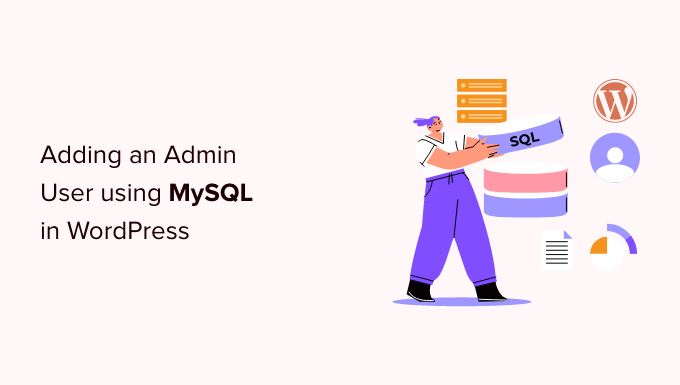
Varför lägga till en administratörsanvändare i WordPress-databasen via MySQL?
Vi stötte en gång på ett problem där en användares webbplats hackades, och deras administratörskonto raderades från databasen. Detta låste dem ute från sin WordPress-webbplats.
Vi kunde hjälpa dem att få åtkomst till sin webbplats genom att skapa en ny administratörsanvändare direkt i WordPress-webbplatsen. Vi gjorde det med phpMyAdmin, ett webbaserat verktyg som låter dig hantera MySQL-databaser med din webbläsare.
Om du befinner dig utelåst från ditt WordPress-adminområde på grund av hackare eller helt enkelt för att du glömt ditt lösenord, kan du göra detsamma.
Du bör dock alltid göra en säkerhetskopia av din databas innan du utför några MySQL-redigeringar. Sedan, när du kan logga in på din webbplats igen, kan du behöva följa vår nybörjarguide för att åtgärda din hackade WordPress-webbplats.
Med det sagt, låt oss titta på hur man lägger till en administratörsanvändare i WordPress-databasen via MySQL.
Lägga till en administratörsanvändare i WordPress-databasen med phpMyAdmin
phpMyAdmin är förinstallerat hos de flesta bästa WordPress-värdföretag. Du hittar det i databassektionen på din värdkontos cPanel-instrumentpanel.
Här är en skärmdump från kontrollpanelen för Bluehost:
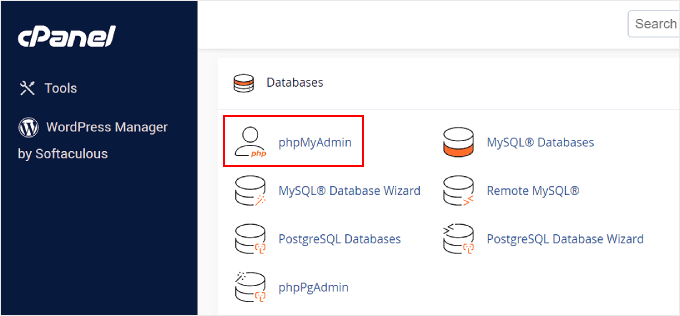
Att klicka på ikonen öppnar phpMyAdmin-gränssnittet. Du behöver välja din WordPress-databas från vänster kolumn.
Därefter kommer phpMyAdmin att visa alla tabeller i din WordPress-databas. Du kommer att göra ändringar i tabellerna wp_users och wp_usermeta.
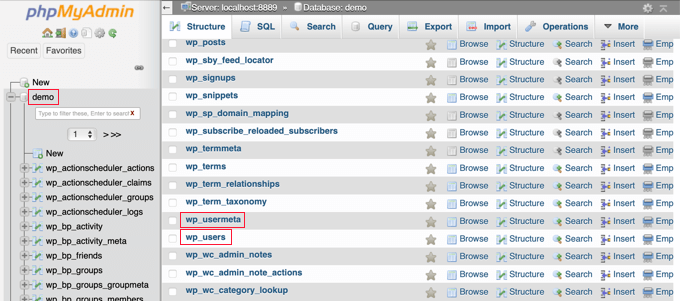
Lägga till en användare i tabellen wp_users
Först måste du hitta tabellen wp_users och klicka på den. Detta visar de användare som för närvarande finns i tabellen.
Lägg märke till i skärmdumpen nedan att det finns två användar-ID:n i vår demo-webbplats tabell, 1 och 2. När vi skapar en ny användare för vår demosida måste detta ID vara unikt, så vi skriver siffran 3.
Du behöver klicka på fliken 'Infoga' högst upp på skärmen så att du kan infoga informationen för en ny administratörsanvändare.
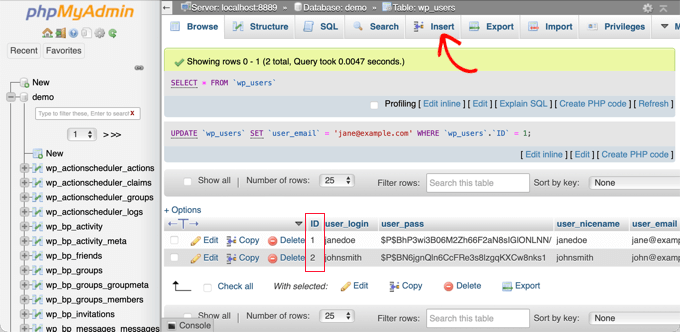
Lägg till följande information i fälten på Infoga-formuläret:
ID: välj ett unikt nummer (i vårt exempel använder vi 3)user_login: användarnamnet som kommer att användas vid inloggninguser_pass: lägg till ett lösenord och se till att välja MD5 i funktionsmenyn (se skärmdumpen nedan)user_nicename: användarens fullständiga namn eller smeknamnuser_email: användarens e-postadressuser_url: din webbadressuser_registered: välj datum och tid då användaren registrerades med hjälp av kalendernuser_activation_key: lämna tomtuser_status: ställ in detta till 0display_name: användarens fullständiga namn eller visningsnamn
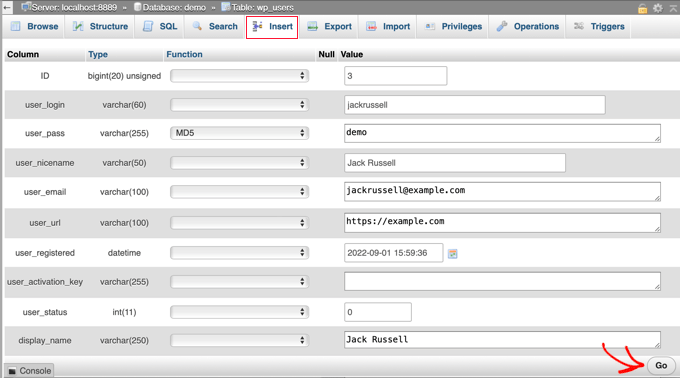
När du är klar, se till att klicka på knappen 'Gå' för att spara den nya användaren.
Lägga till en användare i tabellen wp_usermeta
Nu behöver du hitta tabellen wp_usermeta och klicka på den. Därefter bör du klicka på fliken 'Infoga' som du gjorde i föregående steg.
Därefter behöver du lägga till följande information i infogningsformuläret:
unmeta_id: lämna detta tomt (det kommer att genereras automatiskt)user_id: användar-ID:t du använde i föregående stegmeta_key: detta bör varawp_capabilitiesmeta_value: infoga detta:a:1:{s:13:"administrator";s:1:"1";}
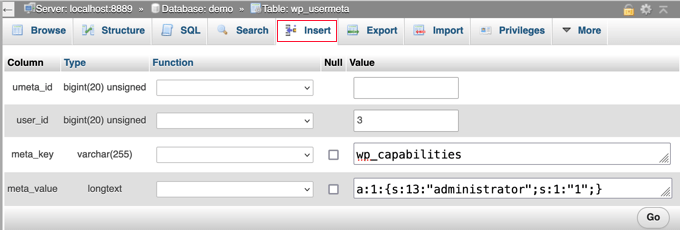
Därefter, när du skrollar ner, bör du hitta fält för en andra rad. Du måste ange följande information:
unmeta_id: lämna detta tomt (det kommer att genereras automatiskt)user_id: användar-ID:t du använde i de föregående stegenmeta_key: du behöver angewp_user_levelmeta_value: 10

När du har angett informationen i fälten måste du klicka på knappen 'Gå'. Grattis, du har skapat ett nytt administratörsanvändarnamn!
Nu bör du kunna logga in på ditt WordPress adminområde med det användarnamn och lösenord du angav för denna användare.
Så fort du loggar in måste du navigera till Användare » Alla användare, klicka sedan på användarnamnet du just skapade.
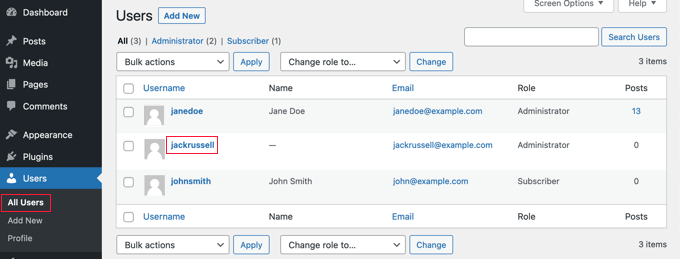
Nu, utan att ändra något, skrolla till botten av sidan och klicka på knappen 'Spara'.
Detta gör att WordPress kan rensa upp användaren du just skapade och lägga till ytterligare information som behövs.
Lägga till en administratörsanvändare i WordPress-databasen med en SQL-fråga
Om du är utvecklare kan du påskynda processen genom att använda kod.
Infoga helt enkelt denna SQL-fråga i din databas:
INSERT INTO `databasename`.`wp_users` (`ID`, `user_login`, `user_pass`, `user_nicename`, `user_email`, `user_url`, `user_registered`, `user_activation_key`, `user_status`, `display_name`) VALUES ('3', 'demo', MD5('demo'), 'Your Name', 'test@example.com', 'http://www.example.com/', '2022-09-01 00:00:00', '', '0', 'Your Name');
INSERT INTO `databasename`.`wp_usermeta` (`umeta_id`, `user_id`, `meta_key`, `meta_value`) VALUES (NULL, '3', 'wp_capabilities', 'a:1:{s:13:"administrator";s:1:"1";}');
INSERT INTO `databasename`.`wp_usermeta` (`umeta_id`, `user_id`, `meta_key`, `meta_value`) VALUES (NULL, '3', 'wp_user_level', '10');
Se till att du ändrar 'databasnamn' till den databas du arbetar med.
Glöm inte heller att ändra de andra värdena till de du vill ha för den nya användaren, som vi förklarade i den första metoden.
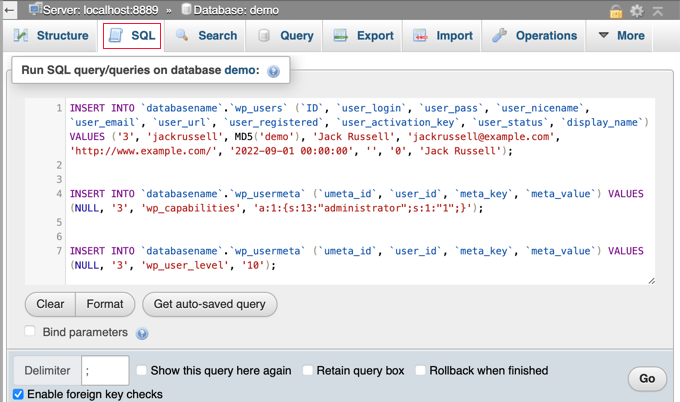
Experthandledare om vad du ska göra när du är utelåst från WordPress-administrationen
Nu när du vet hur du lägger till en administratörsanvändare via MySQL, kanske du vill se några artiklar om hur du fixar din webbplats när du är utelåst från WordPress-adminområdet.
- Vad du ska göra när du är utelåst från WordPress-admin (wp-admin)
- Hur du använder WordPress återställningsläge
- Hur man återställer ett WordPress-lösenord från phpMyAdmin
- Hur man avblockerar Limit Login Attempts i WordPress
- Hur du inaktiverar alla plugins när du inte kan komma åt WP-Admin
- Hur man fixar WordPress White Screen of Death (steg för steg)
- Hur du åtgärdar kritiska fel i WordPress (steg för steg)
- Hur man fixar problemet med att WordPress inloggningssida uppdateras och omdirigeras
- Hur du åtgärdar felet vid upprättande av databanslutning i WordPress
- Hur du enkelt fixar felet "Den här webbplatsen kan inte nås" i WordPress
Vi hoppas att den här handledningen hjälpte dig att lära dig hur du lägger till en administratörsanvändare i WordPress-databasen via MySQL. Du kanske också vill se vår ultimata WordPress-säkerhetsguide eller vår lista över vanliga WordPress-fel och hur du åtgärdar dem.
Om du gillade den här artikeln, prenumerera då på vår YouTube-kanal för WordPress-videoguider. Du kan också hitta oss på Twitter och Facebook.





Kris
Jag ville radera alla skräppostmeddelanden som registrerats på min webbplats. Jag gick till myPhpAdmin och raderade allt, inklusive mitt eget (utan att veta om det). Jag sökte på nätet tills jag hamnade på den här sidan.
Bra jobbat! Det fungerade!
Donato
Inte säker på var jag gjorde fel men jag får detta när jag försöker logga in: Du har inte tillräckliga behörigheter för att komma åt den här sidan.
redhad
Hej Donato,
Ändra "wp_"-prefixet för "wp_capabilities" och "wp_user_level" till det prefix du har angett. Om du till exempel har ändrat ditt WordPress-prefix till "mysite_" bör infogningskommandot vara:
INSERT INTO `databasename`.`mysite_usermeta` (`umeta_id`, `user_id`, `meta_key`, `meta_value`) VALUES (NULL, ‘4’, ‘mysite_capabilities’, ‘a:1:{s:13:”administrator”;s:1:”1″;}’);
INSERT INTO `databasename`.`mysite_usermeta` (`umeta_id`, `user_id`, `meta_key`, `meta_value`) VALUES (NULL, ‘4’, ‘mysite_user_level’, ’10’);
Chetan Dhiman
Tack så mycket! Det hjälpte mig mycket !!!
nishad
Verkligen bra hjälp, jag löste mitt fel med administratörsåtkomst. Tack.
Rupert
Bra inlägg – snabb notering – wp_capabilities och wp_user_level måste matcha prefixet i databasen...
Lou Storiale
Tack för detta... väldigt lätt att följa! Jag skulle aldrig intuitivt ha tänkt att jag skulle behöva lägga till två poster i samma tabell. Tack igen.
Wordpress lägg till admin-post... Jag trodde aldrig att jag skulle ha fått detta gjort på 5 minuter.
Allison Wong
Tack! Jag älskar när saker fungerar! Jag gick igenom instruktionerna som anges ovan och allt fungerade. Bara ett tips – om du har ändrat prefixet på dina databastabeller från wp_ till något annat, se till att ersätta det i koden ovan.
Houston
Tack, Dasha! Du är en livräddare! Var helt fast tills jag insåg att jag också behövde ändra DB-prefixet för 'wp_capabilities' och 'wp_user_level'!
Casey Friday
Detta har hjälpt mig flera gånger, när andra utvecklare skickar mig webbplatser att arbeta med utan att ge mig ett administratörskonto. Tack!
Ruben
Hej, tack för de tydliga tipsen. Det fungerade nästan – men var tvungen att ändra a:1:{s:13:”administrator”;s:1:”1″;} med a:1:{s:13:”administrator”;s:1:”1″;} – ser likadant ut, bara ersätt alla citattecken (som är krulliga citattecken) med vanliga citattecken. Eller var inte lat och skriv det istället för att klippa och klistra. Annars hade den nya användaren jag skapade inte administratörsrättigheter. Phu, det var svårt.
Reena
omg.. vilken livräddare. Bara ett tips, du måste uppdatera wp_capabilities meta_key-värdet till 'a:1:{s:13:"administrator";b:1;}'. Och av någon anledning tillät det mig fortfarande inte att logga in. Så då skrev jag bara in det nya användarnamnet jag skapade och klickade på glömt lösenord. WP skickade mig en länk för att återställa lösenordet och allt var bra.
kapten
hur kan jag lägga till flera bilder i wp_usermeta.
Jamie
Jag kunde komma åt med den ursprungliga processen men nu är min instrumentpanel tom. Några idéer om vad jag behöver göra? tack
Nathan Swartz
Från och med idag måste du också lägga till en annan post (och förmodligen inte wp_user_level, är inte säker på det dock), wp_capabilities med ett värde av a:1:{s:13:"administrator";b:1;}
Erik
Du har en liten bugg. du behöver uppdatera wp_capabilities meta_key-värdet till ‘a:1:{s:13:”administrator”;b:1;}’ för att detta ska fungera korrekt, annars en bra artikel
Gabriel Luethje
Ja, jag blev utelåst tills jag kom på det här.
Daniel Duckworth
Tack Erik!
mitzi
Tack! Både till originalförfattaren och dig för fixen. Räddar mitt skinn just nu…
Keenan Flogerzi
Håller med.
Det kan vara en bra idé att posta den typen av saker med kodformatering, istället för bara vanlig text.
Dasha
Tack för handledningen – mycket användbar. Det vore dock bra om det fanns en notering om att 'wp_capabilities' och 'wp_user_level' använder standarddatabasprefixet, dvs. 'wp_'. Om en webbplats använder ett anpassat DB-prefix bör det användas i dessa strängar istället.
Houston
Tack, Dasha! Du räddade mig!
Juan
Efter att ha hittat din lösning finjusterade jag den lite, du kan faktiskt göra allt i 2 frågor utan att behöva komma ihåg id:t du skapar.
Båda frågorna måste köras i samma åtgärd (alltså samma SQL-inmatningsruta).
INSERT INTO `wp_users` (`ID`, `user_login`, `user_pass`, `user_nicename`, `user_email`, `user_url`, `user_registered`, `user_activation_key`, `user_status`, `display_name`)
VALUES
(NULL , ‘username’, MD5(‘password’), ‘User Name’, ’email@domain.ext’, ”, NOW(), ”, ‘0’, ‘User Name’);
INSERT INTO `wp_usermeta` (`umeta_id`, `user_id`, `meta_key`, `meta_value`)
VALUES
(NULL, LAST_INSERT_ID(), ‘wp_capabilities’, ‘a:1:{s:13:”administrator”;s:1:”1″;}’),
(NULL, LAST_INSERT_ID(), ‘wp_user_level’, ’10’);
Sara
Detta fungerade perfekt! Tack Juan!
codeshark
Detta fungerar perfekt och är mycket enklare än att infoga allt manuellt. Juan, tack och bra jobbat.
Jim
Jag följde instruktionerna men får fortfarande ett felmeddelande om "ogiltigt användarnamn" när jag försöker logga in.
Jag har skapat 3 olika användare men fortsätter att få detta fel.
AndreaCavallieri
Jag har samma problem. Hur kan vi lösa det?
Clare
Så glad att jag hittade detta. Fungerade som en dröm när jag fick de korrekta hakparenteserna och rätt kod för den version av WP som var installerad
ReeZh
Det fungerar! Den här handledningen sparar min tid. Tack så mycket, herr Syed.
aleo monts
STOR TACK!
elad
tack kompis, fungerade som en charm.
Robin Jennings
Fungerade utmärkt. Fin och enkel handledning - mycket uppskattat.
XYZ
Tack så mycket... det fungerade.
Abdul Aziz
fungerar inte, jag vet inte vad jag har gjort för fel...
det visar det här felet
“”” Du har inte tillräckliga behörigheter för att komma åt den här sidan. “”
Steve Della-Valentina
Det verkar som att den senaste versionen av WordPress har justerat sina metanycklar och värden till:
dqf_capabilities -> a:1:{s:13:”administrator”;b:1;}
dqf_user_level -> 10
Jag såg meddelandet om otillräckliga behörigheter innan jag märkte detta, sedan fixade ändringen av nycklar och värden det!
Alvise
Hej, jag försökte men jag får alltid samma varning: Du har inte behörighet……
Vad kan jag göra??
Tack!
Andy
det är citaten. Krulliga citat är inte desamma i din databas. Klistra in den raden i din databas, radera sedan citaten du klistrade in och skriv nya.
mbd
detta är lösningen.. tack
Ginette
Var ok en dag och sedan nästa – förlorade min adminåtkomst. Tack för detta – sparade mig en massa frustration. Dessutom har jag lärt mig lite sql på köpet!
Skål!
Joe Hana
Tack för det här inlägget. Hjälpte mig precis att spara lite tid. Fungerar utmärkt.
Raspal
Hej,
Jag hade en blogg som hostades hos webbhotell A och flyttade nyligen till ett annat webbhotell. Jag har inte längre kontot hos webbhotell A men har en fullständig säkerhetskopia av WP-bloggen på min dator. Jag återställde säkerhetskopian till detta nya webbhotell B och även databasen. Bloggen är tillgänglig utan problem. Men jag kan inte logga in på wp-admin med någon av de tre administratörsanvändarinloggningarna jag har i databasen. Jag kontrollerade databasen från phpMyAdmin och alla tre användarna finns där utan problem.
Jag försökte också ändra lösenord för dessa användare. Jag får länken för att ändra lösenordet, men när jag försöker logga in på wp-admin med det nya lösenordet, får jag fortfarande samma WP-inloggningsskärm utan någon felmeddelande.
Jag försökte också metoden du gav ovan, att skapa en ny användare. Jag gjorde allt enligt stegen och försökte även vad kommentatorerna har föreslagit, men jag kan fortfarande inte logga in.
Jag försökte ta bort alla tabeller för den här bloggen och sedan importerade jag databasen igen. När jag gör detta och försöker logga in får jag bara ett meddelande om att databasen måste uppdateras innan jag kan logga in. Så, när jag klickar på ja, får jag inloggningsskärmen igen och ovanstående process upprepas – jag får samma WP-inloggningsskärm utan fel.
Notera att jag använder WP Better Security-pluginet och försökte till och med ta bort pluginet via FTP, men samma sak, fortfarande.
Kan du berätta vad som kan göras i den här situationen och var jag gör fel? Snälla hjälp.
Tack.
Med vänliga hälsningar,
Raspal
WPBeginner Support
Kontrollera din wp-config.php-fil och se till att den har ditt nya databasnamn, användarnamn och värdinformation. Ta bort .htaccess-filen från roten av din webbplats. Byt namn på plugins-katalogen i din /wp-content/-mapp. Detta kommer att inaktivera alla dina plugins. Slutligen, i phpmyadmin, gå till tabellen wp_options och leta efter alternativen homeurl och siteurl och se till att de pekar på ditt domännamn. Rapportera tillbaka om inget av dessa steg löser ditt problem.
Admin
Raspal
Tack för hjälpen. Jag dubbelkollade allt du nämnde ovan och alla dessa saker var perfekta. Efter 2 dagars pillande slog det mig att jag inte hade försökt rensa Chromes cache och cookies, dumt av mig! Denna enkla sak löste problemen som slösade bort min tid på två dagar. Förlåt att jag slösade bort din och andras tid också som läser detta.
Hur som helst, se till att alla rensar sina cookies och cachemedvetna varannan dag, cookies och cache är ansvariga för riktigt konstiga problem. Jag vet inte om andra men jag gillar att behålla mina cookies i evigheter eftersom de innehåller lösenord till många (inte så viktiga men regelbundna) webbplatser jag besöker. Och jag tar för givet att cookies inte är boven. Visade sig vara fel! Nu har jag skickat mig själv en påminnelse som säger åt mig att rensa cookies och cache från alla mina webbläsare.
Thanks again for the help. At least the options you mentioned, I will surely remember if something like this happens again. And I also learnt how to use phpmyadmin to create and even edit WP users. And in the process, I saw a table called lockdowns. This is created by WP Better Security plugin and I now know that I can clear this table or change the values if I am locked out of the login screen for bad logins. Thanks Syed and editorial staff!
And in the process, I saw a table called lockdowns. This is created by WP Better Security plugin and I now know that I can clear this table or change the values if I am locked out of the login screen for bad logins. Thanks Syed and editorial staff!
Med vänliga hälsningar,
Raspal
Colin Steinmann
Det finns ett mycket litet (men kritiskt) stavfel i din handledning:
a:1:{s:13:”administrator”;s:1:”1″;} <—-detta är inte korrekt med ett enda tecken
a:1:{s:13:"administrator";s:1:"1";} <—-detta är korrekt, det sista " bör vara ett "
De två tecknen ser nästan exakt likadana ut, men de är lite olika.
Julio
Detta var mycket hjälpsamt. Jag fick ett felmeddelande om "inte tillräcklig åtkomst". Efter den här justeringen är vi klara.
Alex
Tack så mycket! Det var lösningen för att få den här handledningen att fungera bra!!!
Tiago
Bra, det fungerar!
Bytte precis ut a:1:{s:13:”administrator”;b:1;} mot motsvarigheten som redan fanns listad i wp-capabilities och det fungerade bra för mig.
Lane
Jag har följt alla dessa steg, men det verkar inte som att min nya användare jag skapade har fått administratörsrollen. När jag loggar in på Wordpress med det användarnamn och lösenord jag just skapade, är allt jag kan se fliken "Profiler" i instrumentpanelen. Uppenbarligen saknar jag ett steg på vägen, men jag har skapat två nya användare som följt detta och det har hänt båda gångerna. Vet någon vad jag kan göra fel?
Haseeb Ahmad Ayazi
Kan jag använda samma procedur för multisite...????
Haseeb Ahmad Ayazi
Fungerade inte… Jag kan inte logga in i mitt multisite-nätverk. Snälla hjälp mig
Hope Corizzo
Wow. Tack så mycket! php gör mig alltid nervös, och jag kunde följa detta väldigt bra. Jag uppskattar det.
Redaktionell personal
Glad it worked out
Admin
alan
Detta fungerar inte, har försökt massor av gånger och kan fortfarande inte logga in.
(unmeta_id – lämna detta tomt (det kommer att genereras automatiskt)
user_id – detta kommer att vara id för användaren du skapade i föregående steg. Kom ihåg att vi valde 4.
meta_key – detta bör vara wp_capabilities
meta_value – infoga detta: a:1:{s:13:”administrator”;s:1:”1″;}
Infoga en ny rad med följande information:
unmeta_id – lämna detta tomt (det kommer att genereras automatiskt)
user_id – detta kommer att vara id för användaren du skapade i föregående steg. Kom ihåg att vi valde 4.
meta_key – detta bör vara wp_user_level
meta_value – 10 )
det här är den del där jag tror att jag gör fel, jag kan se att användaren är skapad men den loggar inte in
Kristian Lander
en användbar guide, till ett problem jag hittade med en hacker som raderade admin-åtkomsten. dock vid insättning av en ny admin. får jag felmeddelandet INSERT command denied to user “databasnamn” @hosting for table “wp_users”
några idéer?
Anthony
Tack, detta fungerar utmärkt. Jag kopierade bara din SQL och ping! Jag använde MySQL Bench, inte phpmyadmin.
Oscar Rottink
Kanske en konstig fråga, men jag följde stegen och kan inte logga in. Tittade också efter hakparenteserna etc.
Så jag försökte 'glömt lösenord' och angav min e-post som också finns i wp_users-tabellen. Men det står att ingen användare är registrerad med den e-postadressen.
Någon som har en aning om vad jag missade?
Oscar Rottink
OMG förlåt. Mitt fel. Jag hade inte ändrat bas-URL:en i databasen så min lokala kopia (och inloggning) pekade på den ursprungliga webbplatsen. Känner mig dum.
Adam
Om du kopierade koden a:1:{s:13:”administrator”;b:1;} från den här bloggen, är det möjligt att du fick krulliga citattecken istället för vanliga citattecken, vilket inte fungerar.
Gleb
Man, thanks! Easiest things get easily forgotten You saved me digging through the database for answers..
You saved me digging through the database for answers..
Jasper Frumau
Tack för det tipset. Nu fungerar det alldeles utmärkt.
Albert A. Ninyeh
Det var ett problem med wp_capabilities-värdet du gav och problemet var med citattecknen. det korrekta är: wp_capabilities ska vara a:1:{s:13:”administrator”;s:1:”1″;}
Alla som vill lösa detta problem bör kopiera det exakt som det visas.
George
Jag loggade av misstag in innan jag lade till "usermeta"-informationen. Det stod förstås "Du har inte tillräckliga behörigheter för att komma åt den här sidan." Även efter att jag lade till usermeta-informationen får jag samma sak.
Några tankar om detta?
Redaktionell personal
Kontrollera om prefixet är detsamma som ditt huvudsakliga databasprefix. Vi antar att användaren använder standardprefixet wp_. Om ditt databasprefix är något annat, så skulle det inte fungera.
Admin
Nat
Jag har provat allt och jag får fortfarande meddelandet "Du har inte tillräckliga behörigheter för att komma åt den här sidan." Några idéer om varför detta kan hända? Tack.
David Abramson
Jag fick samma felmeddelande och jag tror att problemet kommer från kryssrutan i andra raden som säger "ignorera". Den var markerad som standard för mig och jag fick det att fungera när jag avmarkerade den rutan.
JasonC
Tack så mycket, detta gjorde det äntligen möjligt för mig att komma åt min webbplats. Jag försökte alla möjliga alternativ för att återställa administratörslösenordet men inget fungerade. Jag skapade det nya kontot och loggade in som administratör och kunde sedan exportera mitt arbete. Tack igen!
Vic Dinovici
Hej, bra artikel, tack! Har dock ett annat problem, hela min wp_users-tabell blev raderad och jag vet inte hur jag skapar en wp_users-tabell med phpMyAdmin. Kan någon hjälpa till? Tack!
Redaktionell personal
Försökte du reparera din databas med WordPress reparationsverktyg? Kanske det lägger tillbaka den. Annars är det bättre att installera om WordPress. För framtiden, behåll bra säkerhetskopior.
Admin
Vic Dinovici
att använda verktyget för reparation av WordPress-databasen skapar inte wp_users-tabellen. Vad jag gjorde var att radera de oanvända tabellerna från den gamla, sänka dess storlek och ladda upp den igen. Det fungerade. Tack.
sibz
Efter att ha försökt logga in står det...
Du har inte tillräckliga behörigheter för att komma åt den här sidan
varför hände detta?
Tack
Redaktionell personal
Detta händer om din användares behörighetsnivå inte är korrekt. Kan du se till att behörighetsnivån är densamma som för den andra administratörsanvändaren i din phpMyAdmin
Admin
Sibz
I have applied same user level as 10.
But still does not work
Can my developer have any access to my
Cpanel if she doesnt have my ftp or cpanel
Log in details?
I see in phpmyadmin she is listed as admin.
Its all so confusing especially when im new to all
Of this!
Chris Cox
Guiden är föråldrad. Den korrekta strängen för wp_capabilities är nu:
a:1:{s:13:”administrator”;s:1:”1″;}
Redaktionell personal
Uppdaterade guiden.
Aman Yadav
Thanks it worked perfectly for me
John
Tack. Du räddade precis mitt skinn!!
nimbleswitch
Jag upprepar Ravis förslag att kopiera meta-värdet från en annan administratör. I mitt fall var “wp_capabilities” faktiskt databasnamn-“_capabilities” och min administratörsnivå såg ut så här: a:2:{s:13:”administrator”;s:1:”1″;s:17:”gform_full_access”;s:1:”1″;}
Tack för den utmärkta artikeln. Räddade min dag.
Iryna
Att kopiera wp_capabiblities-värdet från en annan administratör hjälpte mig också. I mitt fall var värdet a:1:{s:13:”administrator”;s:1:”1″;}. Fram till denna ändring hade jag fått: ”Du har inte tillräckliga behörigheter för att komma åt den här sidan.”
ravidreams
Tack för den användbara artikeln.
a:1:{s:13:”administrator”;b:1;} fungerade inte för mig. Jag var tvungen att kopiera meta-värdet från en annan administratörsanvändare och sedan fungerade det.
michoscopic
För er som stöter på "Du har inte tillräckliga behörigheter för att komma åt den här sidan.", ersätt "wp_capabilities" med ditt fullständiga WordPress-tabellnamn, t.ex. om dina usermeta-tabeller heter wp_yourtableusermeta (till skillnad från wp_usermeta i den här handledningen), då behöver du använda wp_yourtablecapabilities istället. Samma sak gäller för wp_user_level, ändra det till wp_yourtableuser_level. Hoppas detta hjälper.
MohitBumb
Du har inte tillräckliga behörigheter för att komma åt den här sidan.
mr.minhkhang
Enligt min åsikt bör man inte pilla med MySQL som en 'nybörjare', att mixtra med databasen är helt enkelt inte något för nybörjare.
Jag vet inte när detta publicerades, men tiden då WordPress använde MD5 har sedan länge passerat. Den här artikeln bör uppdateras för att använda wp_hash_password istället.
Tiago
En dag måste du börja pyssla med saker som inte är för nybörjare.. lol
annedreshfield
Hej allihopa, Anne här, praktikant som community manager på Livefyre. Välkomna! Ville bara hoppa in och säga att alla här älskar den här bloggen; den är fullproppad med fantastisk information. Kan knappt vänta på att få läsa mer!
blainesch
Jag var ganska säker på att lösenordet var md5 men det använder också en salt som lagras i konfigurationsfilen.
Kosta Welissariou
Hej,
Jag hoppas få lite hjälp här. Min blogg blev hackad med något base64-skit. Jag kan lösa 99% av alla problem men jag har 2 administratörer i mitt wp-backend som måste tas bort från mysql-tabellen innan jag kan vidta andra åtgärder
Tyvärr, ingen aning om hur man spårar administratören i tabellen och tar bort dem
WP senaste
Åtkomst till mysql-databasen
tks
Kosta
Redaktionell personal
Titta i wp_users-tabellen. Ta bort de användare du inte vill ha.
Admin
phil
If it was salted, just follow the steps, add a real email and have it send you a password reset. Boom. hope that helped.
hope that helped.